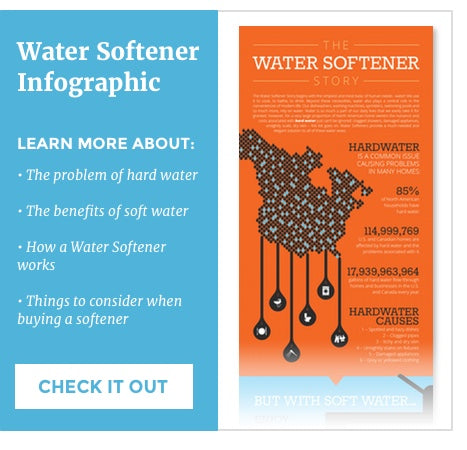How to Properly Size a Water Softener
All across the internet one can find water softener sizing tools that are designed to help consumers pick the right sized softener. Unfortunately the vast majority of these tools fail to incorporate water softener efficiency into the calculation.
 The result is often a choice of softener that seems properly sized yet results in massive salt consumption (often more than 2000 pounds per year) instead of a correctly sized, efficient model that uses 300 pounds over the same year. Why does this happen? It is simply that many dealers - both online and in-store - do not understand the concept of softener salt efficiency and do not incorporate it into their sizing model.
The result is often a choice of softener that seems properly sized yet results in massive salt consumption (often more than 2000 pounds per year) instead of a correctly sized, efficient model that uses 300 pounds over the same year. Why does this happen? It is simply that many dealers - both online and in-store - do not understand the concept of softener salt efficiency and do not incorporate it into their sizing model.
If you haven't done so already, we suggest you read the linked article that describes salt efficiency in full detail: Understanding True Water Softener Capacity
Why Should I Care About Efficiency?
The efficiency of your water softener dictates how much salt you have to buy, how much salt you have to lug, and how much salt gets discharged to the environment. Sizing a softener and considering its salt efficiency will ensure you purchase a softener that never runs out of soft water but also uses the least amount of salt as possible. Over the life span of the water softener, this translates to significant cost savings and ease of ownership.How To Properly Size a Water Softener
Properly sizing a water softener is all about matching your specific water quality and water use to a sufficiently sized system that will minimize salt use and maximize soft water capacity.
The first step in properly sizing your softener is to calculate your "daily softening requirement". This is simply a measure of how much hardness your softener will have to remove daily. Daily softening requirement is calculated using your water hardness info and your water consumption.
Water Hardness
 This is the measure of how much calcium and magnesium is dissolved in your water. Depending on where a water test is performed this information will be reported in mg/L (milligrams per Litre) or GPG (grains per gallon). Grains per gallon is the industry-standard way to discuss water hardness. Diving mg/L by 17.1 will convert it to GPG. A "grain" of water hardness is equivalent to 1/7000th of a pound.
This is the measure of how much calcium and magnesium is dissolved in your water. Depending on where a water test is performed this information will be reported in mg/L (milligrams per Litre) or GPG (grains per gallon). Grains per gallon is the industry-standard way to discuss water hardness. Diving mg/L by 17.1 will convert it to GPG. A "grain" of water hardness is equivalent to 1/7000th of a pound.
It is very important to know your water hardness when you're considering the purchase of a softener. Guessing at this number will result in an improperly sized system. Also, when it comes time to programming your softener it will ask for the hardness value. If you're on your own well you will have to test for hardness. If you're on city water you can usually get the hardness level from your local water utility. Their annual reports can often be found online. When iron is present in the water, the hardness value must be corrected. For every 1.0 ppm or mg/L of iron, 3 GPG of hardness needs to be added to the total hardness value.
Water Consumption
The second factor used to calculate the daily softening requirement is your household is water consumption. The most accurate way to calculate this is to look at a water bill that shows total consumption over a given period of time - usually a month. You can use this information to figure out how much water your household uses per day, on average. If you don't have this information, simply multiply the number of people living in your home by 75 gallons per day. This will give a fairly accurate guesstimate of daily water use.
Now Calculate the Daily Softening Requirement
 Multiply your daily water use by your water hardness (corrected for iron). This number is your Daily Softening Requirement. Here's an example:
Multiply your daily water use by your water hardness (corrected for iron). This number is your Daily Softening Requirement. Here's an example:
Hardness: 10 grains per gallon.
Daily Water Use: 4 People X 75 Gallons per day = 300 gallons per day.
Daily Softening Requirement = 10 grains per gallon X 300 gallons per day = 3000 grains per day.
In the example above, the softener will be removing 3000 grains per day. A softener is usually sized to regenerate about once per week.
Selecting a Softener To Match Your Conditions
At this point you've used your local conditions and your water usage to figure out how much softening is required per day. Water softeners are usually sized so that they regenerate about once per week. Why once per week? A once-a-week regeneration strikes a good balance between keeping the resin bed fresh and not exerting excessive wear and tear on the valve. A water softener valve contains moving parts but these parts only move when the softener is regenerating. Regenerating once-a-week also keeps the water consumption low; a water softener uses about 50 gallons when it regenerates.
 If we take the Daily Softening Requirement of 3000 grains per day and multiple this by 7 days, we need a softener that can soften 21,000 grains of total hardness in order to regenerate once per week. So what size of water softener offers 21,000 grains of total softening capacity? This is where widespread incorrect information found on the internet and elsewhere can hide the real answer.
If we take the Daily Softening Requirement of 3000 grains per day and multiple this by 7 days, we need a softener that can soften 21,000 grains of total hardness in order to regenerate once per week. So what size of water softener offers 21,000 grains of total softening capacity? This is where widespread incorrect information found on the internet and elsewhere can hide the real answer.
A quick look online and in many stores will reveal an abundance of 24,000 / 32,000 / 48,000 / and 64,000 grain capacity water softeners. At first glance it would appear that the 24,000 grain system would be ideal using our example above, where we're looking for 21,000 grains of total softening capacity. Unfortunately the resellers of the 24,000 grain system fail to reveal that it takes 27 pounds of salt to fully regenerate this system to the 24,000 grain level. A more accurate description of the "24,000" system is "0.75 cubic feet". This is the amount of resin this system contains. While it's true that a user can get 24,000 grains of capacity from this amount of resin, it uses a massive amount of salt to accomplish this.
What most dealers call a "32,000" grain system is more accurately described as a "1 cubic foot" system because it contains one cubic foot of softening resin. In order to get 32,000 grains capacity from this system the user would have to use 36 pounds of salt per regeneration! What is very interesting though, is that if you use 6 pounds of salt to regenerate a one cubic foot system, it will yield 20,000 grains of softening capacity. Although the one cubic foot unit will cost a little more than a 0.75 cubic foot unit the savings in salt will make up for this cost difference very quickly. Less salt to purchase, less salt to lug, and less salt discharged to the environment.
High Salt-Efficiency Water Softener Guide
In order to maximize salt efficiency and ultimately save heaps of salt it's important to understand how much softening capacity is yielded by different quantities of resin. Again, these capacities are based on the highest salt efficiencies possible:

